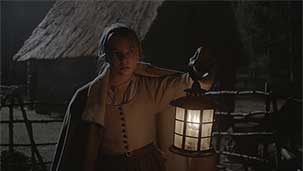You and your director (Robert Eggers—a name which everyone should pay attention to) have crafted a film worthy of early Kubrick. The Witch is a superior piece of filmmaking. The whole experience was a pleasure, both aesthetically and intellectually.
And it’s also scary as shit.
The Witch is a self-assured, mature piece of film craft. Your use of natural light gives the story the kind of pastoral naturalism that contrasts perfectly with the film’s supernatural underpinnings. Despite the rigor of your cinematography (echoing not just Kubrick, but the compositional perfection of Bergman’s Seventh Seal) it is a quiet, understated formalism. Your work is always at the service of the atmosphere of subtle dread that builds over the course of the whole film. The muted tones of autumn and early winter also evoke a patient, inevitable corruption; and the living avatar of that corruption lurks somewhere in the deep woods. Your camera intimates a mood of isolation—these people do not belong in this world.
And who are these people? A family living in self-imposed isolation in 17th Puritan New England, who left the safety of colonial life, largely because it didn’t meet their exacting religious standards. This gives the audience a sense of how utterly committed they are to a particular worldview, and it’s that myopically constricted commitment that serves them up as fodder for the entity that preys upon them. They are as lambs to slaughter just as much because of their blind adherence to their creed as the malevolence of their tormentor.
The performances are all remarkable, each member of the cast in lock step with the other. The dialogue, enriched by having been pulled from primary sources of the period, is both evocative and filled with a kind of nuanced foreboding. It would be almost unfair to single out one player over another since this film, small as it is, had no room for a mediocre performance. But Anya Taylor-Joy as Thomasin, the daughter teetering on the edge of womanhood, was particularly compelling. If any single character carried the weight of the narrative it was she, particularly as the film slid towards it’s foreordained conclusion. This film is utterly Calvinist in its inevitability, yet it never succumbs to the kind of narrative inertia a lot of films like this suffer in their final act. This is largely because the tension has less to do with what will happen and more to do with a more nuanced struggle about where your loyalties lie: to your family, or to your deity.
At its core The Witch is a superior example of gothic horror in the same rarified category as Del Toro’s Devil’s Backbone or The Orphanage. It creates and sustains a level of dread that remains long after the film ends. If you have ever felt an atavistic shiver trying to look into the depths of a tangled wood in the early evening, just imagine that moment stretched out over almost two hours—that’s what you have created for your audience.
The Witch reminded me how small-budget, low-tech filmmaking can produce superior work when it’s informed by exceptional performances, a strong script, a disciplined and clear-eyed director and captured images that build a fully rendered, fully inhabited world. This is one of the best films I have seen in a year filled with some exceptional work.
Sincerely,

Tim







